brake light Citroen DS5 2011 1.G Owner's Manual
[x] Cancel search | Manufacturer: CITROEN, Model Year: 2011, Model line: DS5, Model: Citroen DS5 2011 1.GPages: 348, PDF Size: 10.33 MB
Page 14 of 348

Lighting of the indicator lamp indicates the state of the corresponding function.
Switch panels
Opening the fuel filler flap.
Opening the boot. 63 57 D
eactivation of the alarm.
48, 56
Electric parking brake activated.
9
7
Push button star ting/stopping.
94
Deactivation of Stop & Start.
117
Deactivation of parkin
g sensors.
128
Electric child lock.
161
Deactivation of the DSC/ASR system.
169
Activation of Automatic headlamp
dipping.
137
119
Activation of lane depar ture warning.
5
5
Locking/unlocking the passenger compartment.
Page 16 of 348
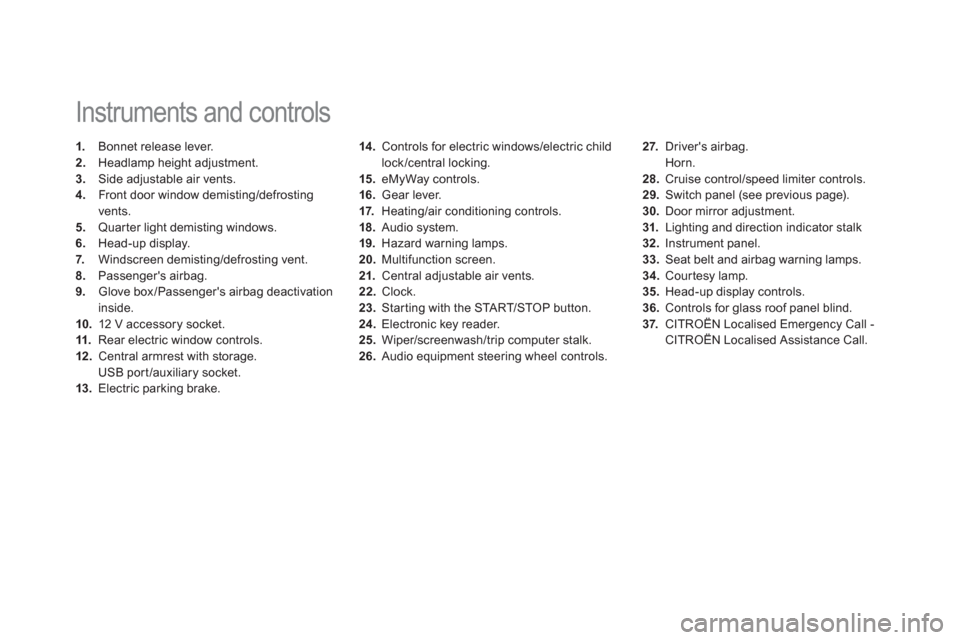
14 . Controls for electric windows/electric child lock/central locking.
15. eMyWay controls.
16.Gear lever.
17. Heating/air conditioning controls.
18
. Audio system.
19.Hazard warning lamps.
20.Multifunction screen.21. Central adjustable air vents. 22.Clock.
23.Star ting with the STA R T/STOP button.
24.Electronic key reader.
25. Wiper/screenwash/trip computer stalk.
26. Audio equipment steering wheel controls.
Instruments and controls
1.
Bonnet release lever.2.
Headlamp height adjustment. 3.
Side adjustable air vents.4.
Front door window demisting/defrosting
vents.
5. Quarter light demisting windows.
6.Head-up display.7. Windscreen demisting/defrosting vent.8.Passenger's airbag. 9.
Glove box/Passenger's airbag deactivationinside.10.12 V accessory socket. 11.
Rear electric window controls.12.Central armrest with storage.
USB por t /auxiliary socket.13.Electric parking brake.
27. Driver's airbag.
Horn. 28. Cruise control/speed limiter controls.29.
Switch panel (see previous page).30.
Door mirror adjustment.
31.Lighting and direction indicator stalk32.
Instrument panel. 33.
Seat belt and airbag warning lamps. 34.Courtesy lamp. 35.Head-up display controls. 36.Controls for glass roof panel blind.37.CITROËNLocalised Emergency Call -
CITROËNLocalised Assistance Call.
Page 26 of 348
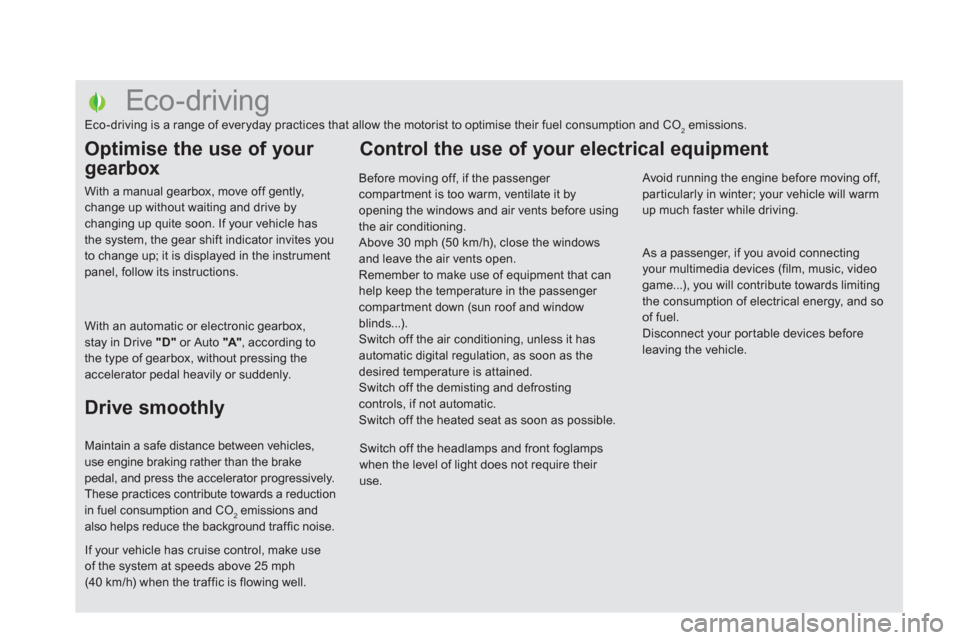
Eco-driving
Eco-driving is a range of everyday practices that allow the motorist to optimise their fuel consumption and CO2emissions.
Optimise the use of your
gearbox
With a manual gearbox, move off gently,change up without waiting and drive by changing up quite soon. If your vehicle has the system, the gear shift indicator invites youto change up; it is displayed in the instrumentpanel, follow its instructions.
With an automatic or electronic gearbox, stay in Drive "D"or Auto "A"
, according to the type of gearbox, without pressing theaccelerator pedal heavily or suddenly.
Drive smoothly
Maintain a safe distance between vehicles,use engine braking rather than the brake pedal, and press the accelerator progressively. These practices contribute towards a reductionin fuel consumption and CO2emissions andalso helps reduce the background traffic noise.
If your vehicle has cruise control, make useof the system at speeds above 25 mph(40 km/h) when the traffic is flowing well.
Control the use of your electrical equipment
Before moving off, if the passenger compartment is too warm, ventilate it byopening the windows and air vents before using the air conditioning.
Above 30 mph (50 km/h), close the windows and leave the air vents open.
Remember to make use of equipment that canhelp keep the temperature in the passenger compartment down (sun roof and windowblinds...). Switch off the air conditioning, unless it has automatic digital regulation, as soon as thedesired temperature is attained.
Switch off the demisting and defrostingcontrols, if not automatic.
Switch off the heated seat as soon as possible.
Switch off the headlamps and front foglamps when the level of light does not require their use.
Avoid running the engine before moving off,particularly in winter; your vehicle will warmup much faster while driving.
As a passenger, if you avoid connecting your multimedia devices (film, music, videogame...), you will contribute towards limitingthe consumption of electrical energy, and soof fuel.
Disconnect your por table devices beforeleaving the vehicle.
Page 96 of 348
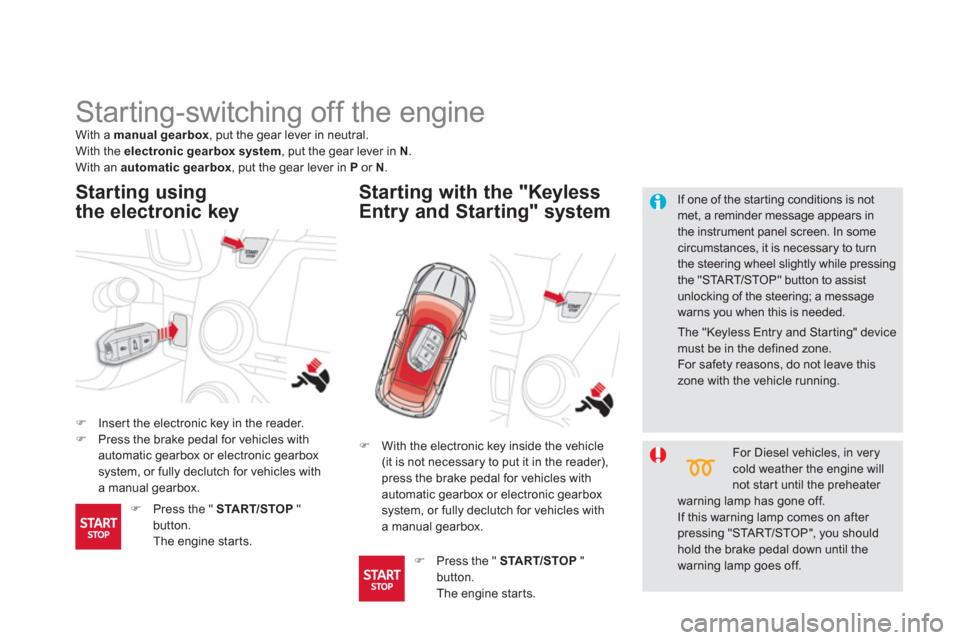
Starting-switching off the engine
�)Inser t the electronic key in the reader. �)Press the brake pedal for vehicles with automatic gearbox or electronic gearbox
system, or fully declutch for vehicles witha manual gearbox.
Starting using
the electronic key
Startin
g with the "Keyless
Entry and Starting" system
If one of the star ting conditions is not met, a reminder message appears in the instrument panel screen. In some circumstances, it is necessary to turnthe steering wheel slightly while pressingthe "START/STOP" button to assistunlocking of the steering; a messagewarns you when this is needed.
With a manual gearbox, put the gear lever in neutral.With the electronic gearboxsystem
, put the gear lever in N.
With an automatic gearbox
, put the gear lever in Por N
.
For Diesel vehicles, in very cold weather the engine willnot star t until the preheater warning lamp has gone off.
If this warning lamp comes on after
pressing "STA R T/STOP", you shouldhold the brake pedal down until thewarning lamp goes off.
�)
With the electronic key inside the vehicle(it is not necessary to put it in the reader),
press the brake pedal for vehicles with
automatic
gearbox or electronic gearbox system, or fully declutch for vehicles with
a manual gearbox.
�) Press the " START/STOP"button.
The engine starts.
�)Press the " START/STOP
"button.
The engine star ts.
The "Keyless Entry and Star ting" devicemust be in the defined zone.
For safety reasons, do not leave thiszone with the vehicle running.
Page 118 of 348
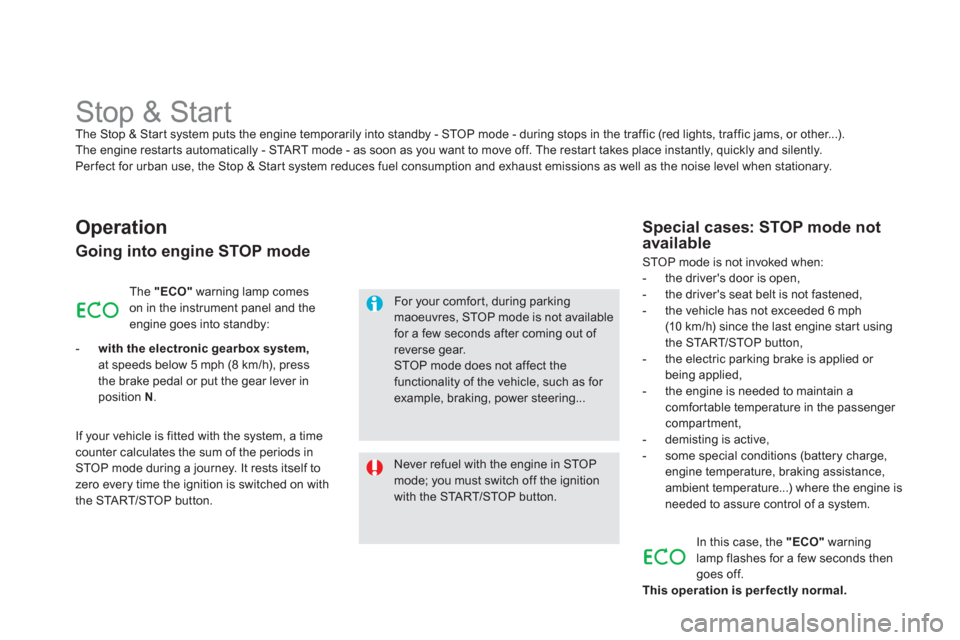
Stop & Start The Stop & Start system puts the engine temporarily into standby - STOP mode - during stops in the traffic (red lights, traffic jams, or other...).
The engine restar ts automatically - START mode - as soon as you want to move off. The restar t takes place instantly, quickly and silently.
Per
fect for urban use, the Stop & Star t system reduces fuel consumption and exhaust emissions as well as the noise level when stationary.
Operation
Going into engine STOP mode
The "ECO"
warning lamp comes
on in the instrument panel and theengine goes into standby:
- with the electronic
gearboxsystem,at speeds below 5 mph (8 km/h), press
the brake pedal or put the gear lever inposition N.
If your vehicle is fitted with the system, a timecounter calculates the sum of the periods in STOP mode during a journey. It rests itself to
zero every time the ignition is switched on with
the STA R T/STOP button.
Never refuel with the engine in STOPmode; you must switch off the ignition with the STA R T/STOP button.
For your comfor t, during parkingmaoeuvres, STOP mode is not available for a few seconds after coming out of reverse gear.STOP mode does not affect the functionality of the vehicle, such as for example, braking, power steering...
Special cases: STOP mode not available
STOP mode is not invoked when:
- the driver's door is open,
- the driver's seat belt is not fastened,
- the vehicle has not exceeded 6 mph(10 km/h) since the last engine start usingthe START/STOP button,
- the electric parking brake is applied or
being applied,
- the engine is needed to maintain acomfor table temperature in the passenger compartment,
- demisting is active,
- some special conditions (battery charge, engine temperature, braking assistance,ambient temperature...) where the engine isneeded to assure control of a system.
In this case, the
"ECO"warning
lamp flashes for a few seconds then goes off.
This operation is per fectly normal.
Page 170 of 348
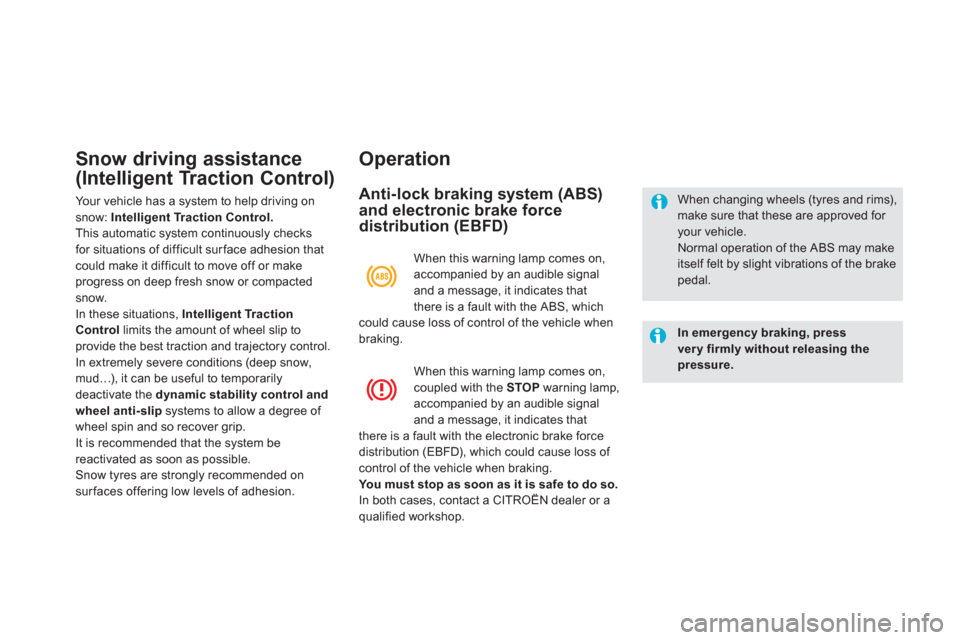
Snow driving assistance
(Intelligent Traction Control)
Your vehicle has a system to help driving onsnow: Intelligent Traction Control.This automatic system continuously checks
for situations of difficult surface adhesion thatcould make it difficult to move off or makeprogress on deep fresh snow or compactedsnow.
In these situations, Intelligent Traction
Contro
llimits the amount of wheel slip toprovide the best traction and trajectory control.
In extremely severe conditions (deep snow,mud…), it can be useful to temporarily deactivate the dynamicstabilitycontroland
wheel anti-slip systems to allow a degree of
wheel spin and so recover grip.It is recommended that the system be reactivated as soon as possible. Snow tyres are strongly recommended on sur faces offering low levels of adhesion.
Operation
Anti-lock braking system (ABS)
and electronic brake force
distribution
(EBFD)
In emergency braking, press very firmly without releasing the pressure.
When changing wheels (tyres and rims),make sure that these are approved for your vehicle.
Normal operation of the ABS may make itself felt by slight vibrations of the brake pedal. When this warnin
g lamp comes on,
accompanied by an audible signal
and a message, it indicates that
there is a fault with the ABS, which
could cause loss of control of the vehicle whenbraking.
When this warnin
g lamp comes on, coupled with the STOPwarning lamp,
accompanied by an audible signal
and a message, it indicates that
th
ere is a fault with the electronic brake forcedistribution (EBFD), which could cause loss of control of the vehicle when braking.
You must stop as soon as it is safe to do so. In both cases, contact a CITROËN dealer or a qualified workshop.
Page 200 of 348
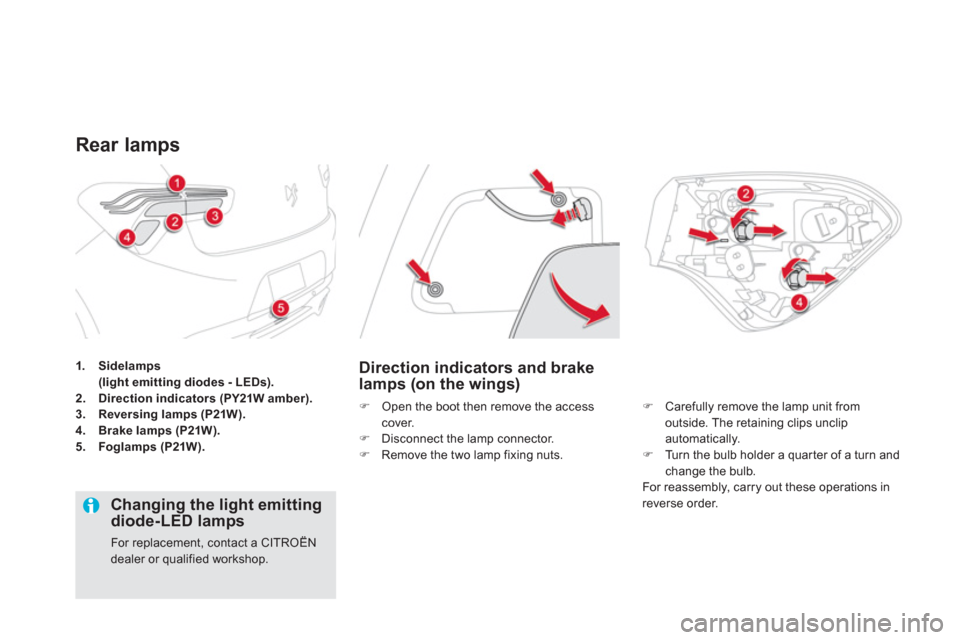
1.Sidelamps(light emitting diodes - LEDs).2.Direction indicators (PY21W amber).3.Reversing lamps (P21W).4. Brake lamps (P21W).5.Foglamps (P21W).
Rear lamps
Direction indicators and brake
lamps (on the wings)
�) Open the boot then remove the access cover.�)
Disconnect the lamp connector. �)
Remove the two lamp fixing nuts.
�)Carefully remove the lamp unit from
outside. The retaining clips unclipautomatically. �)Turn the bulb holder a quarter of a turn andchange the bulb.
For reassembly, carry out these operations in
reverse order.
Changing the light emittingdiode-LED lamps
For replacement, contact a CITROËN dealer or qualified workshop.
Page 202 of 348
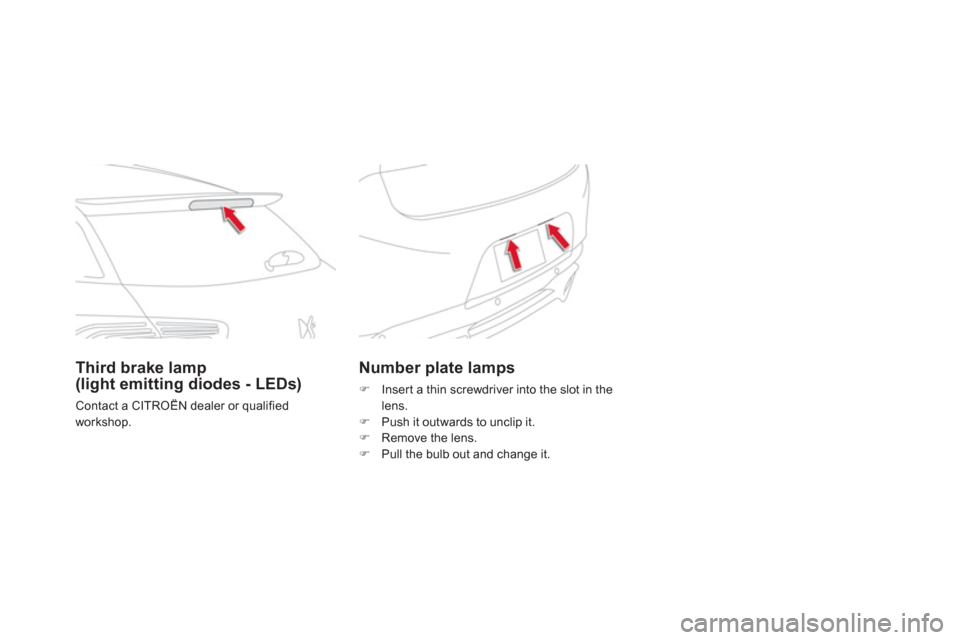
Number plate lamps
�) Insert a thin screwdriver into the slot in the lens.�)
Push it outwards to unclip it.�)
Remove the lens. �)
Pull the bulb out and change it.
Third brake lamp(light emitting diodes - LEDs)
Contact a CITROËN dealer or qualified
workshop.
Page 213 of 348
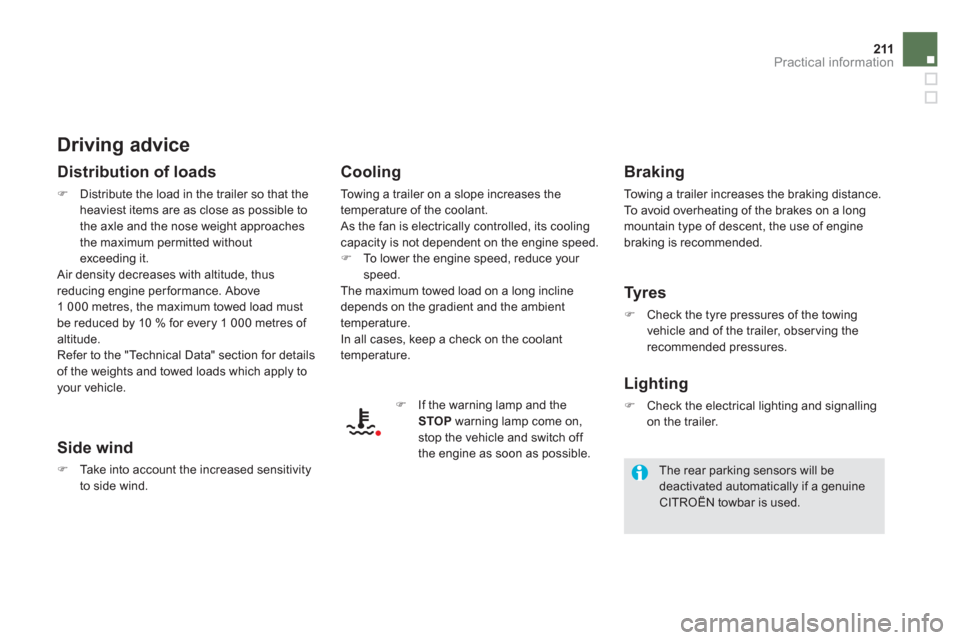
211Practical information
Driving advice
Distribution of loads
�)Distribute the load in the trailer so that theheaviest items are as close as possible to
the axle and the nose weight approaches
the maximum permitted withoutexceeding it.
Air density decreases with altitude, thus
reducing engine performance. Above1 000 metres, the maximum towed load must
be reduced by 10 % for every 1 000 metres of altitude.
Refer to the "Technical Data" section for detailsof the weights and towed loads which apply to your vehicle.
Side wind
�)Take into account the increased sensitivity
to side wind.
Cooling
Towing a trailer on a slope increases the
temperature of the coolant.
As the fan is electrically controlled, its cooling capacity is not dependent on the engine speed. �)
To lower the engine speed, reduce your speed. The maximum towed load on a long inclinedepends on the gradient and the ambient
temperature.
In all cases, keep a check on the coolant
temperature.
�) If the warning lamp and theSTOPwarning lamp come on, stop the vehicle and switch off
the engine as soon as possible.
Braking
To w i ng a trailer increases the braking distance.
To avoid overheating of the brakes on a long
mountain type of descent, the use of engine
braking is recommended.
Tyres
�)
Check the tyre pressures of the towing
vehicle and of the trailer, obser ving the
recommended pressures.
Lighting
�)
Check the electrical lighting and signalling on the trailer.
The rear parking sensors will be deactivated automatically if a genuineCITROËN towbar is used.
Page 235 of 348
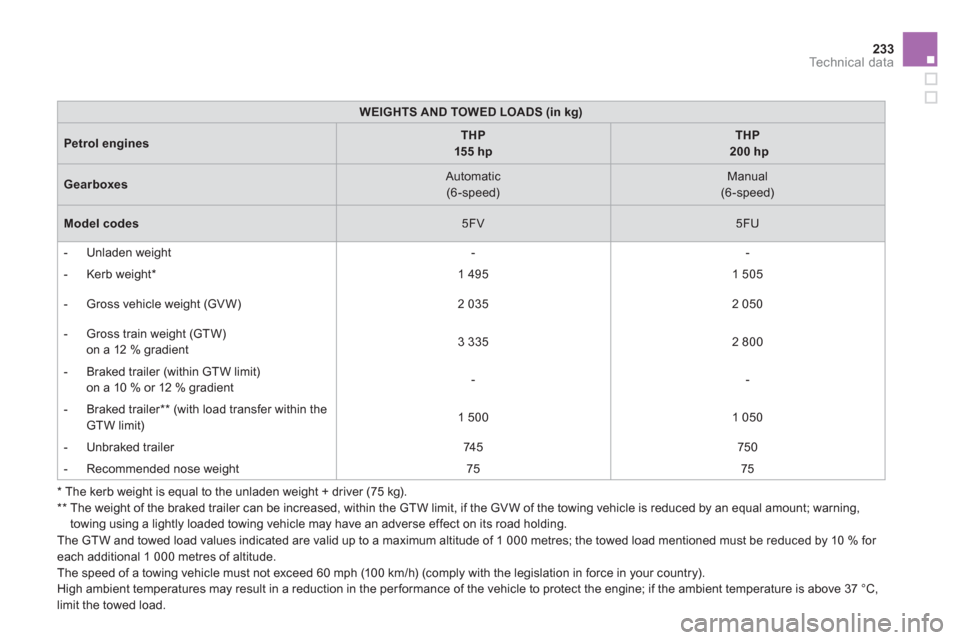
233Technical data
*
The kerb weight is equal to the unladen weight + driver (75 kg).
**
The weight of the braked trailer can be increased, within the GTW limit, if the GV W of the towing vehicle is reduced by an equal amount; warning,
towing using a lightly loaded towing vehicle may have an adverse effect on its road holding.
The GTW and towed load values indicated are valid up to a maximum altitude of 1 000 metres; the towed load mentioned must be reduced b
y 10 % for each additional 1 000 metres of altitude.
The speed of a towing vehicle must not exceed 60 mph (10 0 km/h) (comply with the legislation in force in your country).
High ambient temperatures may result in a reduction in the performance of the vehicle to protect the engine; if the ambient temperature is above 37 °C,
limit the towed load.
WEIGHTS AND TOWED LOADS (in kg)
Petrol enginesTHP155hpTHP200 hp
Gearboxes
Automatic
(6-speed)
Manual(6-speed)
Model codes5FV
5FU
- Unladen wei
ght -
-
- Kerb wei
ght *
1 495
1 505
-
Gross vehicle weight (GVW)
2 035
2 050
-
Gross train weight (GTW)
on a 12 % gradient 3 3352 800
- Braked trailer (within GTW limit) on a 10 % or 12 % gradient-
-
- Braked trailer **
(with load transfer within the
GTW limit)
1 500
1 050
- Unbraked trailer 74 5 75
0
- Recommended nose weight 75
75